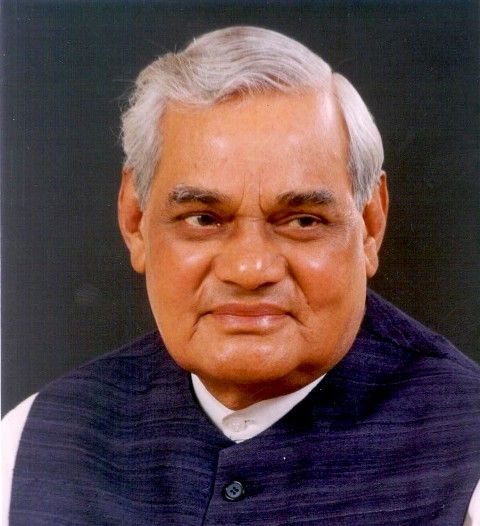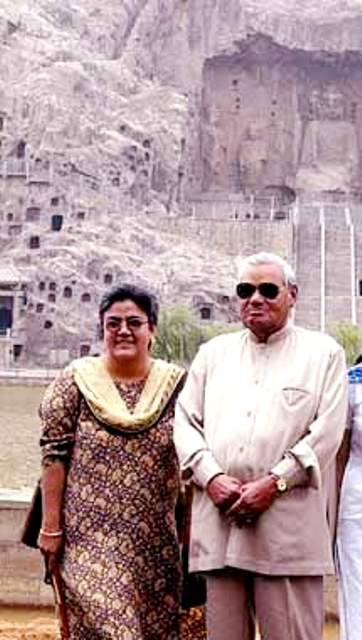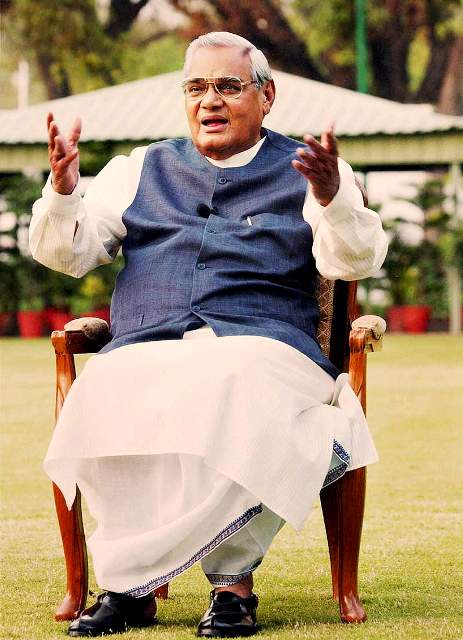
Contents
Atal Bihari Vajpayee Wiki/Biography
Atal Bihari Vajpayee was born on 25th December 1924 to Krishna Devi and Krishna Bihari Vajpayee in Gwalior (now in Madhya Pradesh). His grandfather, Pandit Shyam Lal Vajpayee, had migrated to Morena, Gwalior from his ancestral village of Bateshwar, Uttar Pradesh.
His father, Krishna Bihari Vajpayee, was a poet and a schoolmaster in his hometown. His mother was a home maker.
His current age as of 2018 August is 93 years 8 months.
He has three brothers named Prem Bihari, Avad Bihari and Suda Bihari Vajpayee and three sisters named Urmila, Vimala and Kamala Devi.

He was unmarried but has a foster daughter Namita Bhattacharya and son-in-law Ranjan Bhattacharya,. He has a grand daughter named Niharika.



Atal Bihar Vajpayee Caste, Zodiac Sign Education Health Issues
Atal Bihari Vajpayee did his schooling from Government Higher Secondary School, Gorkhi, Gwalior. He graduated from Victoria College (Laxmi Bai College) and Dayanand Anglo Vedic College Kanpur.
He has done his graduation with distinction in Hindi, English and Sanskrit and completed M.A. in Political Science from DAV college.
His caste is Brahman and belong to a Hindu family. His Zodiac or Sun Sign was Capricorn.
He was 5 ft 6 inches tall and weighs around 80Kg. He has black Eyes with Grey hair.

Vajpayee underwent knee replacement surgery at Breach Candy Hospital in Mumbai in 2001. He suffered a stroke in 2009 which impaired his speech. His health has been a major source of concern and those in the know say he is often confined to a wheelchair and fails to recognise people. He is said to be suffering from dementia and long-term diabetes.
He is not known to have attended any public event in recent years. He rarely ventures out of the house, except for checkups at the All India Institutes of Medical Sciences. On 11 June 2018, he was admitted to a hospital in critical condition and on 16th August he is in life supports system.
Atal Bihari Vajpayee Death Cause, Rumors
Atal Bihari Vajpayee is not dead but is in critical condition due to several media reports. He was admitted to AIIMS om 11th June 2018.
Atal Bihari Vajpayee Career
His activism started with Arya Kumar Sabha of Gwalior, the youth wing of the Arya Samaj, of which he became the general secretary in 1944. He also joined the Rashtriya Swayamsevak Sangh (RSS) as a swayamsevak in 1939, when he was only 15 years old.
His first exposure to politics was in August 1942, when he and his elder brother Prem were arrested for 23 days during the Quit India Movement. In 1957, Atal Vajpayee lost to Raja Mahendra Pratap in Mathura. There, his oratorial skills so impressed Prime Minister Jawaharlal Nehru that he predicted that Atal Vajpayee would someday become India’s Prime Minister.
From 1975 to 1977, Vajpayee was arrested along with several other opposition leaders during the Internal Emergency imposed by Prime Minister Indira Gandhi of the Indian National Congress party.
In the 1977 general elections, he became the Minister of External Affairs in Prime Minister Morarji Desai’s cabinet. As foreign minister, that year he became the first person to deliver a speech to the United Nations General Assembly in Hindi.
Atal Bihari Vajpayee served as the Prime Minister of India between 1996 and 2004. In 1996, Vajpayee was sworn in as the 10th Prime Minister of India, but the BJP failed to muster enough support from other parties to obtain a majority. He resigned after 13 days, when it became clear that he could not garner a majority.
After the fall of the two United Front governments between 1996 and 1998, the Lok Sabha was dissolved and fresh elections were held. The 1998 general elections again put the BJP ahead of others. This time, a cohesive bloc of political parties joined the BJP to form the National Democratic Alliance (NDA), and Atal Vajpayee was sworn in as the Prime Minister.
In May 1998, India conducted five underground nuclear tests in Pokhran desert in Rajasthan, 24 yrs after India conducted its first nuclear test (Smiling Buddha) in 1974. This test is called Pokhran-II. Even there is a movie “Paramanu” released in 2018 featuring John Abraham in a lead role about this Nuclear tests in India.
In the 1999 general elections, the BJP-led NDA won 303 seats out of the 543 seats in the Lok Sabha, in the aftermath of the Kargil operations, thereby securing a comfortable and stable majority. On 13 October 1999, Atal Bihari Vajpayee took oath as Prime Minister of India for the third time.
During his administration, Atal Bihari Vajpayee introduced many domestic economic and infrastructural reforms, including encouraging the private sector and foreign investments, reducing governmental waste, encouraging research and development and privatisation of some government owned corporations. The UPA Government on 1 July 2013 accepted before Supreme Court that National Democratic Alliance Government led by Vajpayee has developed half the roads in last 32 years in their 5-year term.
In March 2000, Bill Clinton, the President of the United States, paid a state visit to India. His was the first state visit to India by a US President in 22 years. President Clinton’s visit to India was hailed as a significant milestone in the relations between the two countries and the major achievement was a significant expansion in trade and economic ties.
Atal Bohari Vajpayee Books Favourite Things
He is fond of Indian music and dance. He loves nature and one of his favourite destination is Manali in Himachal Pradesh.
Awards
- 1992, Padma Vibhushan
- 1993, D. Lit. from Kanpur University
- 1994, Lokmanya Tilak Award
- 1994, Outstanding Parliamentarian Award
- 1994, Bharat Ratna Pandit Govind Vallabh Pant Award
- 2015, Bharat Ratna
- 2015, Bangladesh Liberation War honour (Bangladesh Muktijuddho Sanmanona)
Atal Bihari Vajpayee Books
- India’s Foreign Policy: New Dimensions (1977)
- Assam Problem: Repression no Solution (1981)
- Atal Bihari Vaj Mem Tina Dasaka (1992)
- Pradhan Mantri Atal Bihari Vajpayee Ke Chune Hue Bhashana (2000)
- Values, Vision & Verses of Vajpayee: India’s Man of Destiny (2001)
- National Integration (1961)
- Dynamics of an Open Society (1977)
- Kucha Lekha, Kucha Bhashana (1996)
- Sekyularavada: Bharatiya Parikalpana (Da. Rajendra Prasada Smaraka Vyakhyanamala) (1996)
- Rajaniti ki Rapatili Rahem (1997)
- Back to Square One (1998)
- Decisive Days (1999)
- Sakti Se Santi (1999)
- India’s Perspectives on ASEAN and the Asia-Pacific Region (2003)
Poetry
- Meri Ikyavana Kavitaem (1995)
- Meri Ikyavana Kavitaem (Hindi Edition, 1995)
- Sreshtha Kabita (1997)
- Nayi Disha – An Album with Jagjit Singh (1995)
- Kya Khoya Kya Paya: Atal Bihari Vajapeyi, Vyaktitva Aur Kavitaem (Hindi Edition, 1999)
- Samvedna – An Album with Jagjit Singh (1995)
- Twenty-One Poems (2003)
Thank you for reading this biography on CeleNote. You can read other biographies and TV shows from here.

